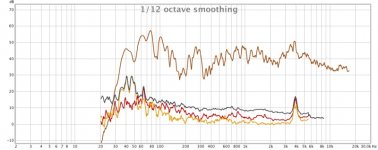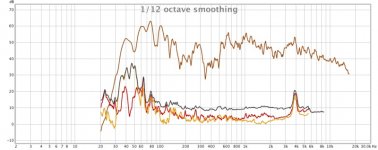Don't ask why I never tried this stunt before.
Ever wonder if you could take honorware/free REW software and use the free mic in your (not quite free) laptop to create performance traces?
Well, if you've had 10,000 reasons not to get off your duff and be brave and test your constructions, now you have only 9,999. As the traces below show, there's hardly any difference between outcomes measured with the 25-cent mic built into my elderly MacBook Air laptop and an individually calibrated IMM-6 mic from Parts Express (not their best, but plenty good for today).
The laptop was in its usual place in my music closet/cabinet and the IMM was set on the keyboard. So the curves aren't too representative of the living room speakers' as heard from my listening position but they are a reasonable way to compare the two mics.
The first chart is the internal mic (BTW, using the IMM nearly ruler flat calibration curve), including THD and 2nd and 3rd harmonic. The second is the IMM. The third is the two FRs overlapped (red is the IMM).
Notice a certain resemblance?
Ben
Ever wonder if you could take honorware/free REW software and use the free mic in your (not quite free) laptop to create performance traces?
Well, if you've had 10,000 reasons not to get off your duff and be brave and test your constructions, now you have only 9,999. As the traces below show, there's hardly any difference between outcomes measured with the 25-cent mic built into my elderly MacBook Air laptop and an individually calibrated IMM-6 mic from Parts Express (not their best, but plenty good for today).
The laptop was in its usual place in my music closet/cabinet and the IMM was set on the keyboard. So the curves aren't too representative of the living room speakers' as heard from my listening position but they are a reasonable way to compare the two mics.
The first chart is the internal mic (BTW, using the IMM nearly ruler flat calibration curve), including THD and 2nd and 3rd harmonic. The second is the IMM. The third is the two FRs overlapped (red is the IMM).
Notice a certain resemblance?
Ben
Attachments
Last edited:
I've had good luck with a really good mic in an old laptop once, a HP circa 2009. The mic was so good I removed it when the laptop died, put the capsule in an old pen body and made it a standalone mic that I used for a couple of years until it died.
I've also had really bad luck with every other laptop mic I've ever tried. The results I got from trying maybe 6 other laptops were everywhere between not remotely accurate and not good enough.
If you get lucky your laptop mic might be accurate. But you won't know unless you test it against a known good source - either another mic or by taking a measurement of something that's already been measured to compare against.
I would advise in taking EXTREME caution before trusting ANY mic whether it's in a device (laptop, phone, tablet, etc) or a standalone mic.
This is why I bought a calibrated UMIK from CSL even though I have at least a dozen mic capsules lying around that I could have used.
Not to mention - don't ever trust a computer soundcard either until tested and vetted. My current laptop has the most terrible response curve I've ever seen on any device. It's truly reprehensible and shouldn't be used for any purpose (either listening or measuring) without calibration. And this was an expensive laptop - it retailed for $1000 when new (but of course I got it for a lot less than that).
I've also had really bad luck with every other laptop mic I've ever tried. The results I got from trying maybe 6 other laptops were everywhere between not remotely accurate and not good enough.
If you get lucky your laptop mic might be accurate. But you won't know unless you test it against a known good source - either another mic or by taking a measurement of something that's already been measured to compare against.
I would advise in taking EXTREME caution before trusting ANY mic whether it's in a device (laptop, phone, tablet, etc) or a standalone mic.
This is why I bought a calibrated UMIK from CSL even though I have at least a dozen mic capsules lying around that I could have used.
Not to mention - don't ever trust a computer soundcard either until tested and vetted. My current laptop has the most terrible response curve I've ever seen on any device. It's truly reprehensible and shouldn't be used for any purpose (either listening or measuring) without calibration. And this was an expensive laptop - it retailed for $1000 when new (but of course I got it for a lot less than that).
Just illustrating how easy it is make useful measurements and there's no excuse for not documenting claims about one's own DIY project with good empiricial evidence.What are you thinking of doing with it?
Ben
Now compare a gated measurement.....
Have you considered the disruptive possibility of putting your laptop one meter from the speaker?
I think acoustic measurements are almost always "soft". Therefore, it is to the credit of a skilled tester to figure out how to get useful data from soft measurements.
The great majority of measurements I make follow this pattern. Do a measurement however imperfect. Crank the silk-screened labeled knob on your equalizer or crossover an unmarked amount. Test again. Or raise speaker a few inches, or hang absorbent, or whatever.
A laptop measurement will be just a good as a thousand dollar B&K device for that kind of before and after.
All I'm saying is "better to light one candle than to curse the darkness".
Ben
Last edited:
- Status
- This old topic is closed. If you want to reopen this topic, contact a moderator using the "Report Post" button.


